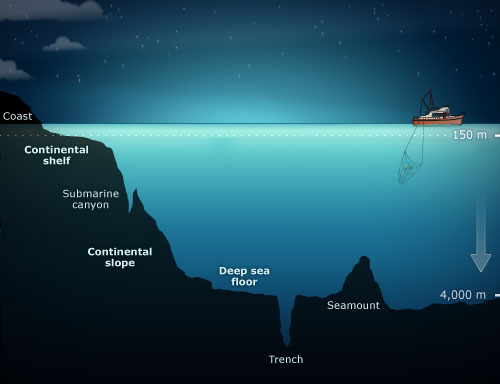Home » Paleontology (Page 10)
Category Archives: Paleontology
Mystery Monday, St. Patrick’s Day ed.
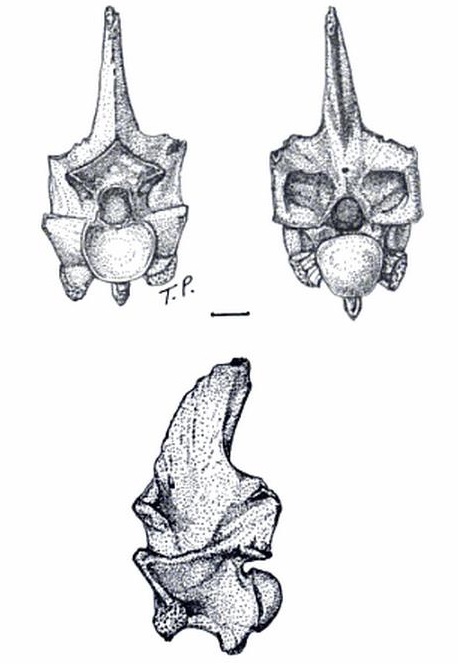
Happy St. Patrick’s Day! In honor of the day, today’s Mystery Monday fossil is related to the legend of St. Patrick. You can probably easily notice it is not a fossil shamrock, which has never been found in Arkansas, unlike the previous owner of this fossil. Finding a 4-leaf clover is generally considered lucky, you probably wouldn’t think the same thing if you found one of these alive. I could find no pictures of the actual fossil and I don’t have access to it, so I hope you will forgive me for using an illustration from the paper that described it.
Fossil Friday, make it a Productive one
Were you able to solve Monday’s mystery fossil? They aren’t little poop balls, nor are they clams, although they are often mistaken for them.
This photo can be found at the Arkansas Geological Survey website under “Brachiopod.” They look a lot like clams. Brachiopods, often called lamp shells, have two shells and live in shallow marine environments just like clams and the occupy the same niche, feeding on organics filtered from the water. But unlike clams, which are molluscs, just like snails and squid, brachiopods are lophophorates, most closely related to bryozoans, the “moss animals.”.

Bryozoan lophophore. http://www.geol.umd.edu/
So what is a lophophorate? Lophophorate means “crest or tuft bearer, so named for their feeding apparatus called a lophophore, which is shaped like a roughly circular or semi-circular ring of tentacles. These tentacles lazily wave through the water passing through the lophophore, catching small particles of food suspended in the currents. Thus, everything in this group are what is known as suspension feeders. These lophophores serve not only to collect food, but for gas exchange as well. In addition, the animals are headless, with the lophophore surrounding the mouth. The food enters the mouth and passes through the digestive tract, which makes a U-turn and dumps out what it can’t digest just outside the ring of tentacles. Clams do essentially the same thing, only they use an entirely different apparatus to do so.
Clams attach themselves to surfaces by secreting a collection of what are called byssal threads. Most brachiopods, on the other hand, form a pedicle, a stalk that holds them in place. Some do not make pedicles, instead just gluing themselves down directly onto the rock.

Symmetry in a brachiopod and clam. http://www.kgs.ku.edu
Another difference that can usually be seen between clams and brachiopods is the symmetry of their shells. Brachiopods are symmetrical from side to side, their left side is the same as their right side. Clams follow a different pattern. They usually have two identical shells, but the shells themselves are not symmetrical. This is not always true though. The Cretaceous oyster, Exogyra ponderosa, has an huge, thick shell on one side and a thin lid for a shell on the other. But as a general rule, this usually works. Another difference that is sometimes stated is that brachiopods use their muscles to close their shells, while clams use their muscles to open their shells, closing them by the use of ligaments; thus making brachiopods more susceptible to predators. This, however, is not true. In truth, brachiopods use their muscles to both open and close their shells. Clams have large adductor muscles that function to close the shells and they have ligaments that open them when the muscles relax.
 Brachiopods are quite diverse, with many different types. They range in size from less than a dime to almost 40 cm (15″). There are two general groups, the Articulates, which have toothed hinges holding the shells together, and the Inarticulates, which do not have teeth, so they fall apart easily after death. Probably the most commonly found in Arkansas are spirifers, known for being somewhat wing-shaped , with a prominent sulcus, or depression in the center. Many brachiopods prefer solid substrates, like rock, others were adapted for softer substrates like sand or mud.
Brachiopods are quite diverse, with many different types. They range in size from less than a dime to almost 40 cm (15″). There are two general groups, the Articulates, which have toothed hinges holding the shells together, and the Inarticulates, which do not have teeth, so they fall apart easily after death. Probably the most commonly found in Arkansas are spirifers, known for being somewhat wing-shaped , with a prominent sulcus, or depression in the center. Many brachiopods prefer solid substrates, like rock, others were adapted for softer substrates like sand or mud.  Productids, like the ones in our mystery fossil, often grew spines, which helped secure them to muddy surfaces. Others, like strophomenid brachiopods, handled muddy substrates by developing large, very flat shells, which floated on the mud like a snowshoe.
Productids, like the ones in our mystery fossil, often grew spines, which helped secure them to muddy surfaces. Others, like strophomenid brachiopods, handled muddy substrates by developing large, very flat shells, which floated on the mud like a snowshoe.  Still others, like the modern-day lingulids, developed long pedicles, allowing them to burrow down into the sediment.
Still others, like the modern-day lingulids, developed long pedicles, allowing them to burrow down into the sediment.
Brachiopods have been around since at least the Cambrian, over 520 million years ago. They were most abundant in the Paleozoic Era, but suffered greatly during the Permo-triassic extinction event. They recovered to some extent, but never reached their previous abundance due to the appearance of clams, which began taking over some of the spaces they occupied. Nevertheless, there are still several different kinds in the modern ocean and can often be seen clinging to rocks near shore or buried in the sand. In Arkansas, you won’t find any living specimens, but you can find numerous fossil brachiopods in the Paleozoic rocks throughout the Ozarks and Boston Mountains, even in some places of the Arkansas Valley. Stop by any outcrop along Highway 65 between Conway and the north edge of the state, particularly limestone outcrops, and you are likely to find some. You can find a few in the Bigfork Chert in the Ouachitas, but they are not nearly so common as they are farther north.
Fossil Friday, don’t be a wet blanket
Despite the snow, we didn’t get a chance to have any other posts this week other than the Monday Mystery fossil. We did, however, have three different school trips in the past couple of weeks to talk to kids about fossils, dinosaurs, and the skeletal system, as well as giving talks on the fossils telling us about the origins of crocodiles and dinosaurs, as well as attending a talk on the origins of birds. So a lot of paleo work, just not much showing up here. Fortunately, some of you had some time to examine our mystery fossil and congratulations to Laurenwritesscience for coming up with the correct answer.
It is indeed a stromatolite. Bruce Stinchcomb has a video on Youtube showing several examples of Ozark stromatolites and providing a good explanation of what they are.
http://www.youtube.com/watch?v=yvox7-UDta8
Essentially, stromatolites are microbial ecosystems, built up of layer after layer of microbial mats. The general description is that of blue-green algae, which forms a sticky layer over the surface of a rocky surface in a shallow marine or coastal environment. Blue-green algae are not actually algae and are better referred to as cyanobacteria. These bacteria are photosynthetic, just like plants, so they need sunlight, thus limiting the depth at which they can be found. Actually, they are typically found right at the water’s edge in the tidal zone. This sticky substance, while maintaining their hold on the rock, also tends to collect sand, clay, and organic debris. Over time, all the stuff that sticks to the mat blocks the sunlight from the cyanobacteria and they migrate above the layer and build another mat, which collects more debris, which causes them to build another mat, etc. Stromatolites form much the same way as piles of laundry. By the time you finish washing one set, there is another pile forming in a neverending stream. The life of a cyanobacteria in a stromatolite is a depressing condition of always digging themselves out from under a pile just to get dumped on again. I am sure most people can empathize.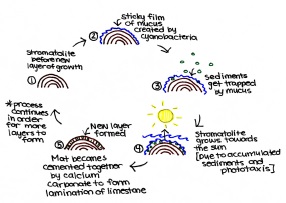
The sticky mucus (properly referred to as extrapolymeric substance, or EPS for short, but we can go with mucus here) forming the mat does more than just cause things to stick to it. The mat protects the bacteria in from ultraviolet radiation. It also allows the bacteria to control the microenvironment around them, keeping such things as pH levels in a good range. It also has an unfortunate aspect for the bacteria. The mucus allows the levels of calcium and carbonate ions to build up until they precipitate out of the water as calcium carbonate, also known as calcite (when referring to the mineral), or limestone (when referring to the rock). So not only are the poor bacteria constantly getting buried, they are getting turned to stone in their very own medusa nightmare. Life is hard as a cyanobacteria. But just wait, it gets worse.
 These microbial mats are not just cyanobacteria, though. There are lots of other organisms that live in and on them. There are many other types of bacteria. There are sulfate reducing bacteria, which use sulfur like we use oxygen, only they release hydrogen sulfide instead of carbon dioxide, causing a nice rotten egg smell. There are purple sulfur bacteria that eat the hydrogen sulfide, as well as colorless sulfur bacteria that eat both the hydrogen sulfide and the oxygen released by the cyanobacteria, thus free-loading off of everyone. In addition to bacteria, there are plenty of prokaryotes (organisms without nuclei that holds their DNA) and eukaryotic (with nuclei) single-celled and multi-celled organisms living in the mat. Diatoms, single-celled photosynthetic organisms that grow their own shell, live on top, while nematodes burrow through the mat. In addition to all this, a wide variety of animals love to chow down on the mats. Everything from snails, sea urchins, crabs, crawfish, and just regular old fish happily eat them. As a result, there are not a lot of places left in the world you can find stromatolites growing. The Bahamas and Shark’s Bay, Australia are the best areas to find them.
These microbial mats are not just cyanobacteria, though. There are lots of other organisms that live in and on them. There are many other types of bacteria. There are sulfate reducing bacteria, which use sulfur like we use oxygen, only they release hydrogen sulfide instead of carbon dioxide, causing a nice rotten egg smell. There are purple sulfur bacteria that eat the hydrogen sulfide, as well as colorless sulfur bacteria that eat both the hydrogen sulfide and the oxygen released by the cyanobacteria, thus free-loading off of everyone. In addition to bacteria, there are plenty of prokaryotes (organisms without nuclei that holds their DNA) and eukaryotic (with nuclei) single-celled and multi-celled organisms living in the mat. Diatoms, single-celled photosynthetic organisms that grow their own shell, live on top, while nematodes burrow through the mat. In addition to all this, a wide variety of animals love to chow down on the mats. Everything from snails, sea urchins, crabs, crawfish, and just regular old fish happily eat them. As a result, there are not a lot of places left in the world you can find stromatolites growing. The Bahamas and Shark’s Bay, Australia are the best areas to find them.
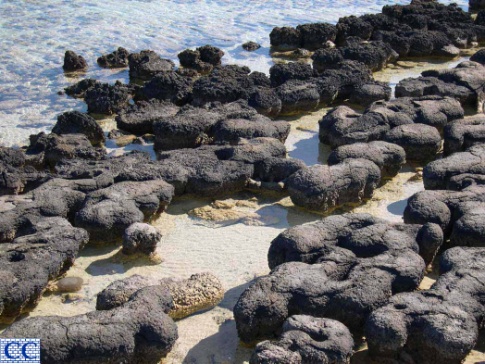 They may be rare now, but at one time, they ruled the earth. As some of the oldest living communities in the world, they have been around for at least 3.5 billion years (that’s 3,500,000,000, or roughly 600,000 times the length of human civilization) and for more 2/3 of that time, they were the only game in town and in all probability served as the cradle for all eukaryotic and multi-cellular organism on the planet. These days, if you live in Arkansas, the only places you can find them are as fossils in the Cambrian age Cotter Formation and Ordovician age Everton Formation in the Ozark Plateau.
They may be rare now, but at one time, they ruled the earth. As some of the oldest living communities in the world, they have been around for at least 3.5 billion years (that’s 3,500,000,000, or roughly 600,000 times the length of human civilization) and for more 2/3 of that time, they were the only game in town and in all probability served as the cradle for all eukaryotic and multi-cellular organism on the planet. These days, if you live in Arkansas, the only places you can find them are as fossils in the Cambrian age Cotter Formation and Ordovician age Everton Formation in the Ozark Plateau.
For further information (and the source of the images shown here), check out the stromatolite page at the Arkansas Geological Survey and the Microbe Wiki stromatolite page, as well as the Microbes.arc.nasa.gov site, which supplies a nice teacher’s guide to teaching all about microbial mats, designed for grades 5-8.
Fossil Friday! The Red-faced Fossil
Between classes and school appearances, I have not had the time to write up as complete a description as I would like, so I will do a more complete description of the fossil later. But for now, did any of you think you saw crinoids in the face? If you did, you are correct! This photo was originally published on the Arkansas Geological Survey‘s blog. If you haven’t checked them out, I encourage you to do so.
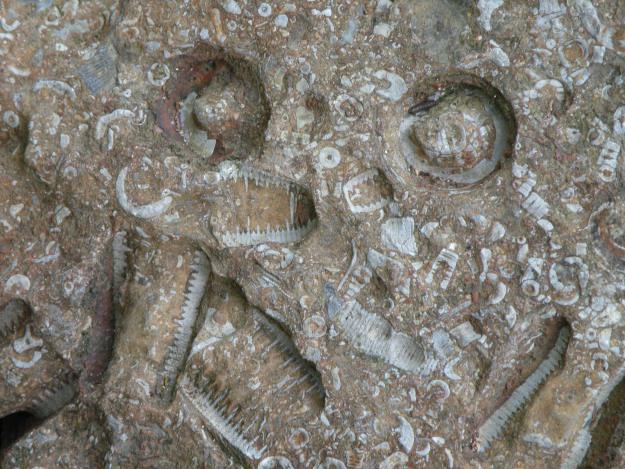
Crinoids are perhaps the most common fossil found in Arkansas. They can be found in many of the Paleozoic rocks in northern Arkansas in the Ozarks and Ouachitas, although they are most common in the Mississippian age limestones of the Ozarks. All those white rocks along Highway 65 towards Leslie and Marshall are good candidates, although watch out for cars along the highway, please.

Stellar examples of crinoids in all their fossilized glory. This image and more information can be found at http://www.ucmp.berkeley.edu/echinodermata/crinoidea.html
Crinoids are often called sea lilies because of their resemblance to plants, but they are actually animals that are related to sea urchins and starfish, so they are far more closely related to you than to any plant. Even though they lived in shallow marine environments during the Paleozoic Era, you can still find them today in deep water along what is called the continental slope. If you swim out into the deep water a long way away from shore and you get to the edge of the continent, you will see a cliff or steep slope descending all the way down to the abyss of the absolute bottom of the ocean. Congratulations, you have reached the continental slope and the last refuge of the crinoids.
Mystery Monday! Can you identify the fossils in the face?
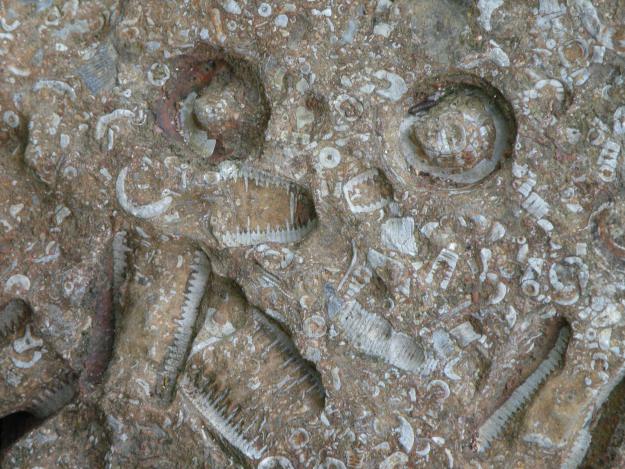
It’s another Monday! You know what that means, right? The end of the weekend, an extra dose of coffee to get the day started, and a new fossil for Mystery Monday. Today’s fossil is a very common fossil in Arkansas. Some people think these fossils form a kind of spooky face. Bonus points if you can say where the picture came from. Once I tell you what it is, you should check out all the other cool info they have.
Fossil Friday! Today we’re being a stick in the mud.
On Monday, we posted this picture of an Arkansas fossil. Were you able to figure it out?
This is a fossil of Calamites (watch your spelling, we want to avoid any calamities). Calamites was a relative of the modern-day horsetails, Equisetum. But unlike today’s horsetails, which are generally only a meter or so in height (although some giant horsetails can grow up to 7 meters or more), Calamites grew up to 30 meters (100 feet).
Equiseta often grow clonally, spreading the rhizomes widely through the surrounding ground, forming large clumps of plants that are essentially the same plant, connected via their roots. Assuming Calamites did the same thing, it has been estimated “they may have been the largest organisms that ever lived.” This group of plants is unique in the incorporation of silica into their stems, giving rise to one of their common names being scouring rushes.
This group of plants first appeared in the late Devonian, but really had their heyday in the Carboniferous Period, although they died out soon after in the Permian. The Carboniferous is so named because most of the world’s coal was formed during this time. The reason for this is because of the difficulty in digesting plant matter. Cellulose, the primary ingredient in plant cell walls and what we call “dietary fiber.” Even today, other than fungi and some bacteria, there is precious little that can break it down. Lignin, the other main component of plant cells walls, otherwise known as “wood,” is even harder to break down.

And they think they have a termite problem. http://www.ces.ncsu.edu
The only thing that can really digest it is white rot fungi. Back then, there was little to nothing that could eat it. As a result, dead plant matter tended to sit around for a very long time, making it much more likely to accumulate and form coal. Once the enzymes needed to break down lignin evolved, white rot fungi found themselves with a hugely abundant food supply and acted like teenaged football players after a game at an all-you can-eat buffet. And thus ended the Carboniferous Period, in a massive bout of white rot.
Like modern horsetails, Calamites preferred wet soils around rivers and lakes, cropping up all over the world. While they avoided the standing water of the swamps, they flourished any place that regularly got wet, so levees and floodplains were good environments for them. There were no angiosperm trees at that time, what was there were forests of giant Calamites and ferns. Plants called lycopods, most commonly Lepidodendron, dominated the swamps along with the ferns, which were pretty ubiquitous.
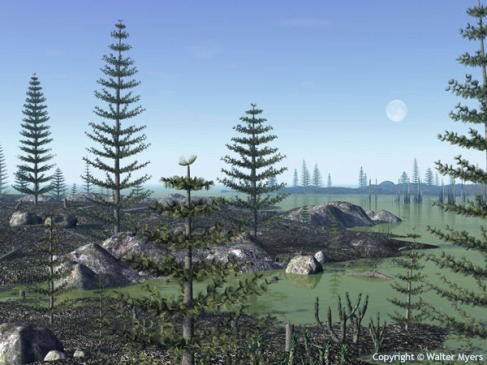
Calamites landscape. Illustration by Walter Myers, http://www.arcadiastreet.com
Calamites’ modern counterparts are all herbaceous perennials, so Calamites is unique in the group for having a woody trunk. They form extensive underground rhizome networks, growing large clumps of clones from the rhizomes. The leaves form regularly spaced whorls around the stem, creating the horizontal lines breaking up the ridges running vertically up the trunk on Calamites. Inside, the xylem forms rays running from the exterior to the pith in the center. Oftentimes, the pith rots away, leaving a cavity that gets filled with sediment, forming an internal cast, or steinkern.
As a plant fossil, anyone can legally collect Calamites fossils as long as they are not on National Forest property (nothing is allowed to be collected in National Parks and Forests). Good places to look for Calamites would be among the Pennsylvanian (Late Carboniferous) rocks in the Quachitas and Ozarks. While Calamites may be found in rocks of Mississippian (Early Carboniferous) age, the rocks in Arkansas from that age are primarily marine. Good for finding sea shells, but land plants like Calamites are going to be rare, only there as a result of being washed in by a storm or some such. You will be much more likely to find them in rocks like the Atoka Formation on both sides of the Arkansas River Valley. Most of the Ozarks is Mississippian, but much of the Ouachitas is Pennsylvanian, so are much more likely to have them. You might find them in the Hartshorne sandstone (seen best capping Petit Jean Mountain), but plant fossils are rare and fragmentary. You would have better luck in the McAlester Formation overlying the Hartshorne. You can also try the Savanna and Boggy Formations, which are also of Pennsylvanian age.
Mystery Monday!

It’s time for Mystery Monday! Here is a fossil that can be found in Arkansas, but is completely different from anything I’ve put up here before. Let’s see if you have the paleontological fiber needed to solve this puzzle, or do you lack the stomach for it? 🙂
Fossil Friday, to bear or not to bear, that is the question
It’s Friday again. Were you able to get the answer to Monday’s fossil?
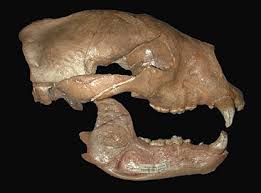 The skull shown in the picture belonged to Arctodus simus, the giant, short-faced bear (the not-so-giant short-faced bear, A. pristinus, was smaller and lived in more southerly areas than A. simus). Arctodus lived in Arkansas and much of North America during the late Pleistocene, from less than 1 million years ago up to about 12,000 years ago, when most of the large North American Ice Age fauna went extinct. Arctodus was the North American version of the European cave bear, Ursus speleaous. While the European cave bear was a close relative of most modern bears, Arctodus was more distantly related, its only living relative being the spectacled bear, Tremarctos ornatus. It is sometimes considered possibly the largest terrestrial, mammalian carnivore that ever lived, standing over 3.5 m ( 11.5 ft) tall. Even on all fours, it was almost 2 m (6.5 f) at the shoulder. You would have to get at least 4.5 m (almost 15 ft) up a tree to avoid its reach, assuming it didn’t just tear the tree down or shake you out of the tree. It weighed in at a full ton and could run 40 mph (over 60kph). However, that is also the top range of modern Kodiak brown bears, otherwise known as Alaskan grizzly bears. In the wild, the bears don’t usually get over 1500 pounds (although they can), but the largest ever known was a bear in the Bismarck, ND zoo that weighed 2130 lbs at his death and previously weighed possibly close to 2400 lbs, although he was a very fat bear. There is another bear pelt on display at Space Farms Zoo and Museum in New Jersey that is claimed to be from a bear over 12 ft. tall and over 2,000 lbs, but those claims remain unverified are considered by most to be exaggerated. There is another bear that may have been even bigger. Arctotherium angustidens lived in South America about three million years ago and stood almost 3.5 m tall, so similar to Arctodus and the largest of extant bears, but was much more robust, weighing in the neighborhood of 3,500 lbs.
The skull shown in the picture belonged to Arctodus simus, the giant, short-faced bear (the not-so-giant short-faced bear, A. pristinus, was smaller and lived in more southerly areas than A. simus). Arctodus lived in Arkansas and much of North America during the late Pleistocene, from less than 1 million years ago up to about 12,000 years ago, when most of the large North American Ice Age fauna went extinct. Arctodus was the North American version of the European cave bear, Ursus speleaous. While the European cave bear was a close relative of most modern bears, Arctodus was more distantly related, its only living relative being the spectacled bear, Tremarctos ornatus. It is sometimes considered possibly the largest terrestrial, mammalian carnivore that ever lived, standing over 3.5 m ( 11.5 ft) tall. Even on all fours, it was almost 2 m (6.5 f) at the shoulder. You would have to get at least 4.5 m (almost 15 ft) up a tree to avoid its reach, assuming it didn’t just tear the tree down or shake you out of the tree. It weighed in at a full ton and could run 40 mph (over 60kph). However, that is also the top range of modern Kodiak brown bears, otherwise known as Alaskan grizzly bears. In the wild, the bears don’t usually get over 1500 pounds (although they can), but the largest ever known was a bear in the Bismarck, ND zoo that weighed 2130 lbs at his death and previously weighed possibly close to 2400 lbs, although he was a very fat bear. There is another bear pelt on display at Space Farms Zoo and Museum in New Jersey that is claimed to be from a bear over 12 ft. tall and over 2,000 lbs, but those claims remain unverified are considered by most to be exaggerated. There is another bear that may have been even bigger. Arctotherium angustidens lived in South America about three million years ago and stood almost 3.5 m tall, so similar to Arctodus and the largest of extant bears, but was much more robust, weighing in the neighborhood of 3,500 lbs.
Arctodus is generally known for its long legs and short face. However, research in the past decade has indicated that its legs were neither longer than expected, nor was its face all that short. It was simply big. Like other bears, it is thought to be fairly solitary most of the time. Contrary to many depictions, it was not particularly adapted to running quickly, considering that modern grizzlies can run 30 mph. What may have made people think they were unusually fast is a combination of their size giving them long legs and tracks that have indicated they used a pacing gait, with the legs on the same side of the body moving in unison, rather than in opposition like most other animals. This sort of gait is typically used in animals with longer legs or at faster trots. Camels use it and dogs and cats, among others, do it when maintaining a trot before they break into more of a gallop. However, the pacing gait is not indicative of a fast-running animal, but of an animal that maintains a quick pace for long distances, it bespeaks of endurance, not speed.
Like most bears, Arctodus is thought to have been omnivorous, eating both plants and animals. There have been several hypotheses concerning its diet, from mostly scavenging to hypercarnivorism. It was certainly capable of bringing down large prey, although its limbs were not as flexible as most high level predators, nor were they particularly robust for their size, leading some to think they scavenged, although they would be hard-pressed to compete with giant vultures in scavenging and recent work indicates the tooth structure was not sufficient for chomping through bone. They may have been better suited for foraging plant material with their unusually flexible wrist giving them an almost semi-opposable thumb, much like pandas. This suggests possible tree-climbing to some workers, although Arctodus was a very large animal to be climbing trees. Besides, it typically lived in more open, grassland environments the majority of the time, so it is unlikely to have been adapted for tree-climbing.
They went extinct roughly 11,000 years ago, along with a large number of other large species. A reduction in rich food supplies is thought to have caused the extinction of the large herbivores. This would have placed a great deal of stress on the carnivores, causing increased competition. The dire wolves lost out to the modern grey wolves during this time, chiefly thought to be a result of the gray wolves being able to hunt and subsist on smaller and fewer prey than the larger dire wolves. This same reasoning would apply to Arctodus as well, which had to compete against both wolves and other bears, for a greater percentage of the share to fuel its larger body. On the other hand, evidence for this hypothesis has been lacking in analyses of tooth wear.
If you want to see more of Arctodus, make your way to the La Brea Tar Pits in Los Angeles. many bones of this bear have turned up from the tar and are on display at the Page Museum.
Fossil Friday, a fossil of not quite mammoth proportions
 It’s time to reveal the answer to Monday’s Mystery Fossil. We had three people who correctly identified this as the skull of Mammut americanum, the American Mastodon.
It’s time to reveal the answer to Monday’s Mystery Fossil. We had three people who correctly identified this as the skull of Mammut americanum, the American Mastodon.
Mastodon bones have been found throughout Arkansas, although almost all have been found either in northeast Arkansas between Crowley’s Ridge and the Mississippi River or along the Red River in Southwest Arkansas. According to the Arkansas State University Museum in Jonesboro, Arkansas has more mastodon finds than any other state in the mid-south region, with at least 20 different skeletons. Most of the work on them has been done by Dr. Frank Schambach and others of the Arkansas Archaeological Survey, headquartered at the University of Arkansas at Fayetteville, along with members of the Arkansas State University Museum. This particular mastodon was excavated by Dr. Schambach with the help of the Arkansas Archaeological Society along the Red River in Southwest Arkansas, I think in 1987, although I am not sure of the date yet.
Mastodons were related to elephants, although not as closely related to modern elephants as mammoths. Mammoths have also been found in Arkansas, most notably the Hazen mammoth, found in 1965. That specimen was a Columbian mammoth (Mammuthus columbi), a less hairy version of the wooly mammoth (Mammuthus primigenius). They lived across much of North and Central America during the Miocene and Pliocene, although they are known mostly from the Pleistocene in Arkansas, the heyday of the Ice Age, which is when people traditionally think of them living. They were similar in size to modern elephants.
The teeth of mastodons, mammoths and modern elephants tell an interesting story. Modern elephants have a wide diet of vegetation from grass to fruit and tree limbs. The Asian elephant has teeth that are more plate-like in form, making a series of ridges that create an excellent grinding surface. African elephants spend more time in forests and bush lands, with a corresponding higher amount of bushy vegetation in their diet. Their teeth are large, multi-rooted teeth with a series of ridge-like cusps. Mammoths take the plate-like grinding surface to an extreme as an adaptation to the grasslands they frequented. Mastodons, on the other hand, specialized in the opposite direction, with large, prominent cusps suited to a more forested environment and diet. Thus, mastodons and mammoths formed a bracket surrounding elephant ecology.

Mastodon (left), Mammoth (right). http://www.igsb.uiowa.edu/
Work that has recently come out has shed new light on why they went extinct. People have long argued over whether climate change or humans wiped out the megaherbivores at the end of the last ice age. The Overkill hypothesis postulated that early humans hunted them to extinction. There is also the alternative that other actions by early humans contributed to their extinction. However, while there has been plenty of evidence indicating humans did hunt mammoths (e.g. the Clovis people at the Dent site in Colorado), the hypothesis has come under fire for the lack of widespread hunting evidence and timing issues, with research indicating the megaherbivores were already going extinct before humans appeared on the scene. The other hypothesis, climate change, has gotten more support from a study of plant fossils. According to the new data, the early tundra environments were dominated, not by grass, but by forbs, weedy herbaceous plants with more nutrients than grasses. An earlier glaciation 20-25,000 years ago dramatically reduced the abundance of these plants. When the weather warmed up, the forbs increased again, but never approached their previous levels. When the next glaciation hit, the forbs mostly died out, allowing the less nutritious grasses to take over, which greatly reduced the amount of herbivores the land could support. Of course, this does not mean that humans had nothing to do with the extinctions, but it does mean they were likely not the primary cause, more likely simply throwing the last spear into the coffin of the great herbivores.
That’s it for this week. Check back Monday for a new mystery fossil. Have a good weekend.
You found a fossil… now what? (all the details!)
One of the questions I get often is what should you do if you find a fossil. I have been meaning to write a post discussing that, but I found that someone else had already written a very nice discussion on that very topic. I thought why duplicate the efforts of someone else who has done a fine job already? So instead of writing my own post, I am just going to refer you to their blog post. So without further ado, may I present…





